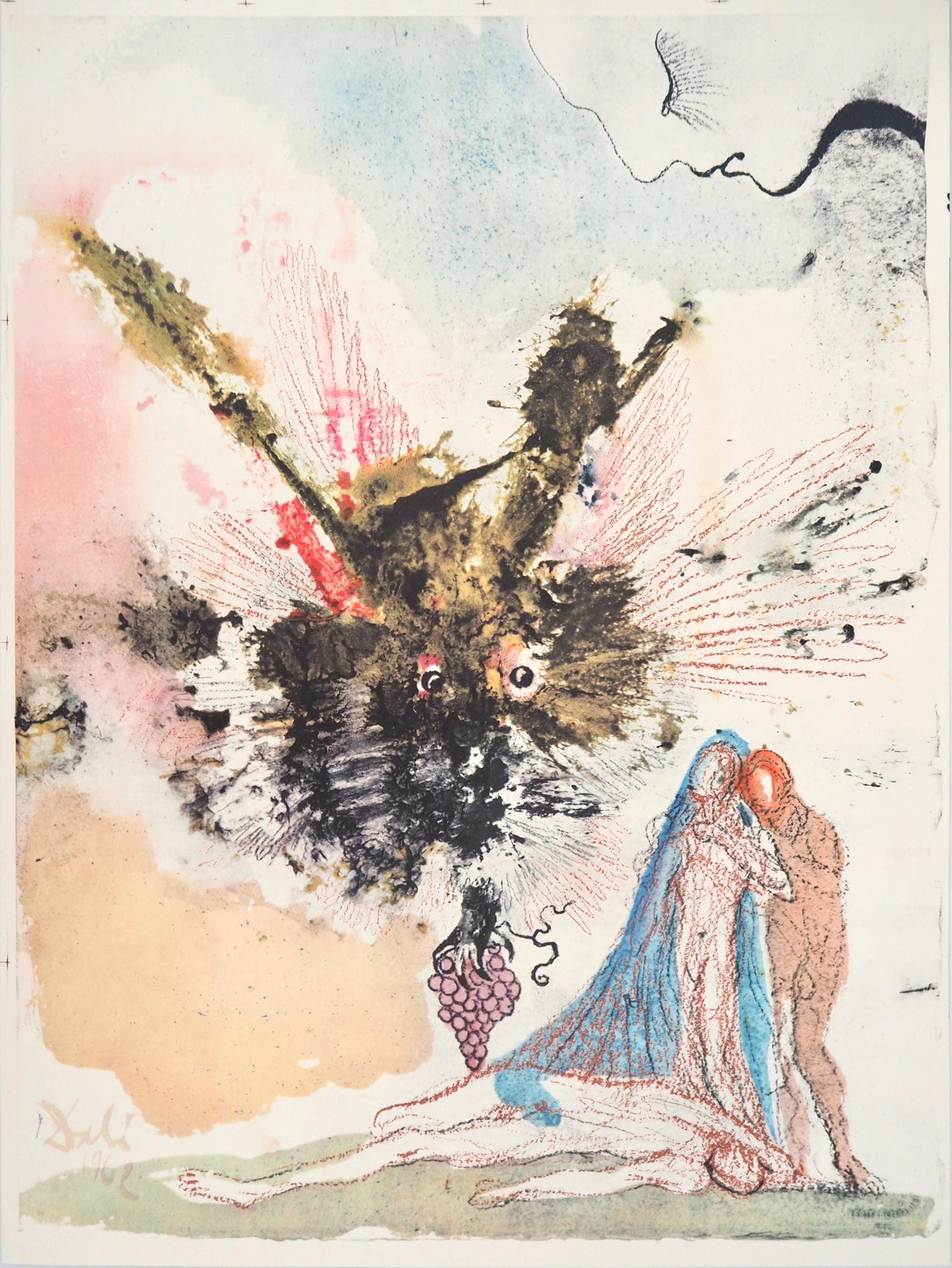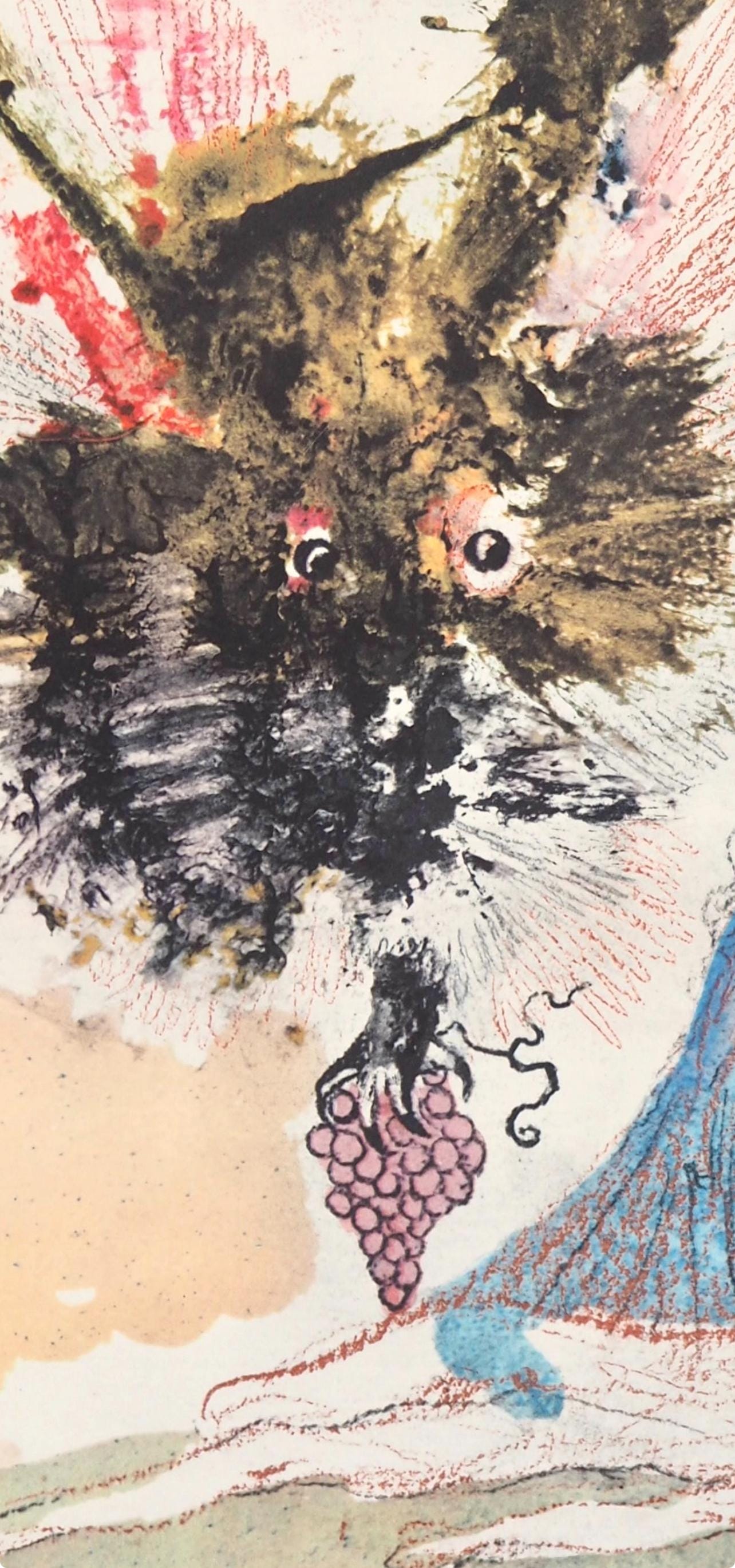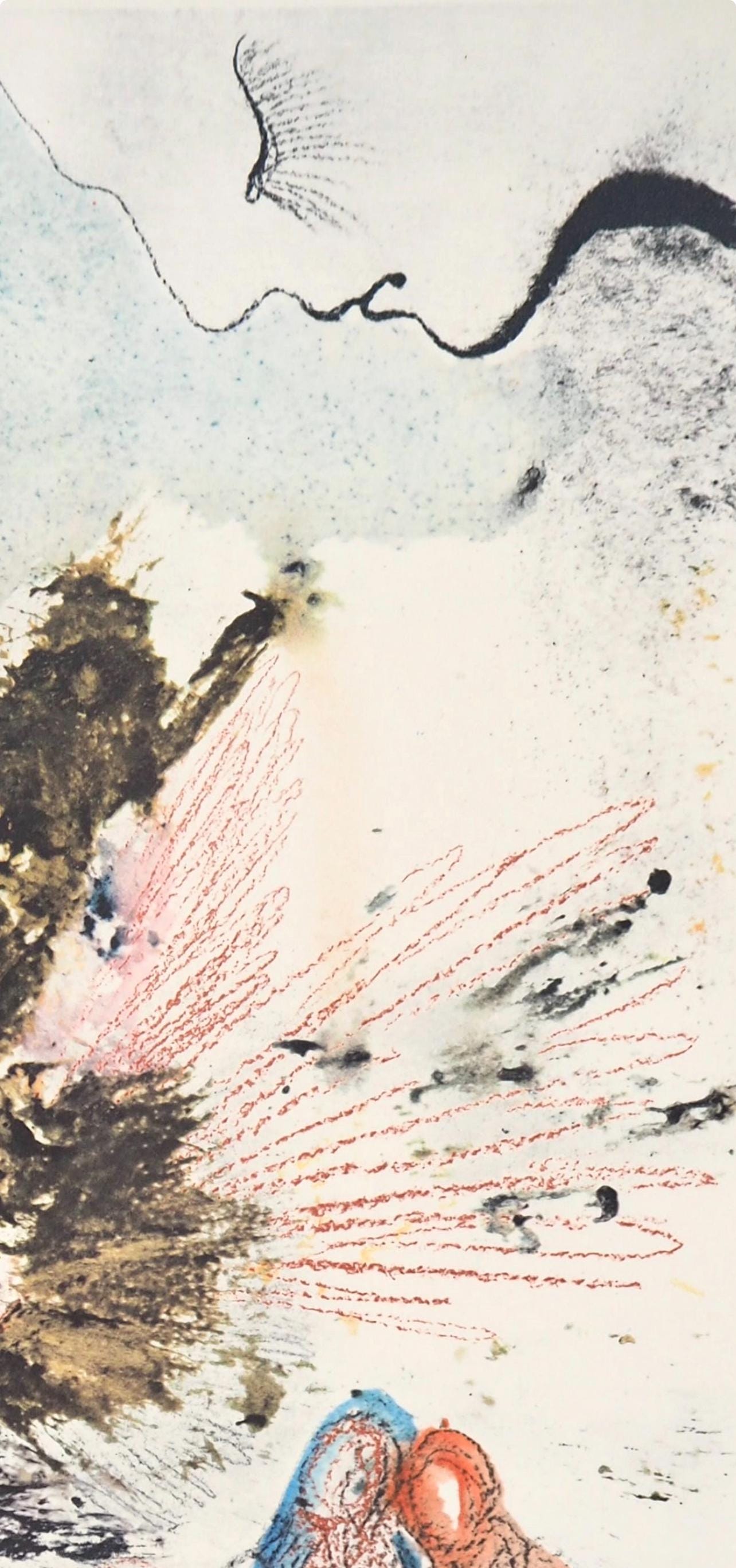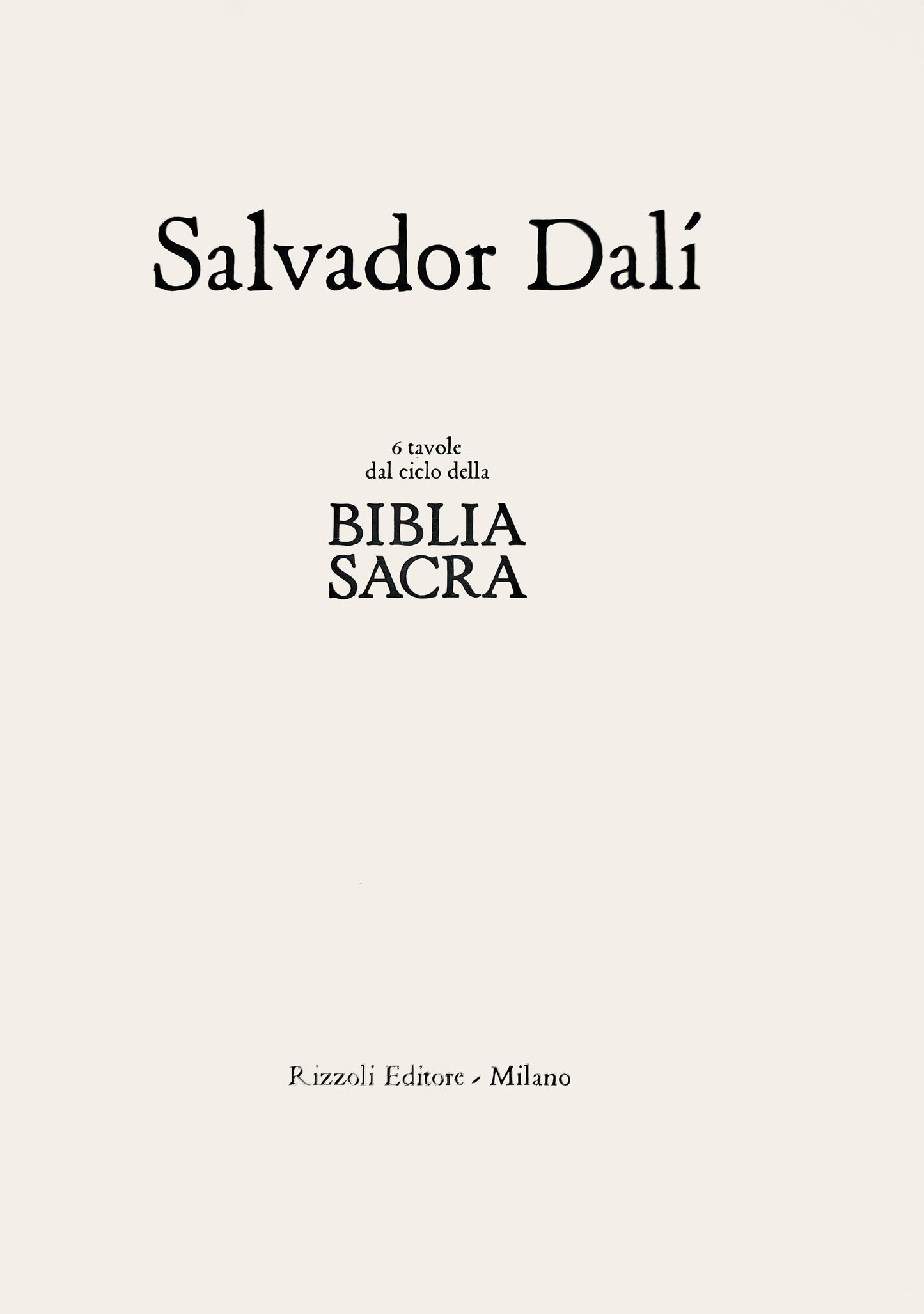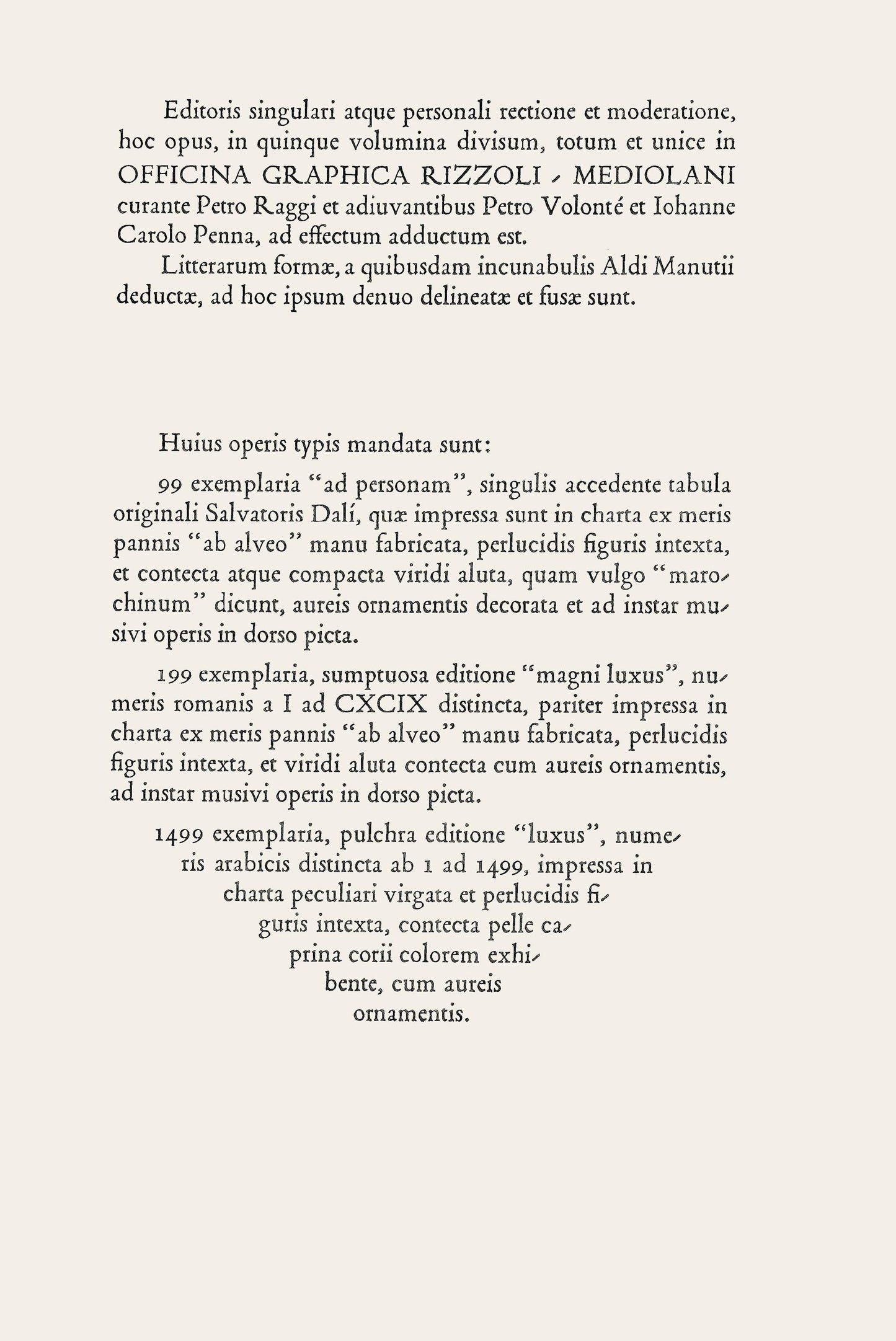1
/
of
9
Auction Ended: September 04, 2025
Post-Auction Sale Ends in:
Salvador Dali, Composition (Michler/Lpsinger 1600; Field 69-3), Biblia Sacra, Lithograph
Salvador Dali, Composition (Michler/Lpsinger 1600; Field 69-3), Biblia Sacra, Lithograph
Regular price
$1,232.46 USD
Regular price
$0.00 USD
Sale price
$1,232.46 USD
Unit price
/
per
Couldn't load pickup availability
Condition: Pre-Owned
Lithograph in colors on vlin Fabriano charta ex meris pannis "ab alveo" manu fabricata, perlucidis figuris intexta paper. Paper size: 19 x 13.75 inches. Inscription: Signed in the plate and unnumbered, as issued. Catalogue raisonn references: Field, Albert, and Salvador Dali?. The Official Catalog of the Graphic Works of Salvador Dali. S. Dali? Archives, 1996, illustration 69-3. Michler, Ralf, et al. Salvador Dali: Catalogue Raisonne? of Prints. Prestel, 1994, illustra......
Lithograph in colors on vlin Fabriano charta ex meris pannis "ab alveo" manu fabricata, perlucidis figuris intexta paper. Paper size: 19 x 13.75 inches. Inscription: Signed in the plate and unnumbered, as issued. Catalogue raisonn references: Field, Albert, and Salvador Dali?. The Official Catalog of the Graphic Works of Salvador Dali. S. Dali? Archives, 1996, illustration 69-3. Michler, Ralf, et al. Salvador Dali: Catalogue Raisonne? of Prints. Prestel, 1994, illustra......
Condition: Pre-Owned
Lithograph in colors on vlin Fabriano charta ex meris pannis "ab alveo" manu fabricata, perlucidis figuris intexta paper. Paper size: 19 x 13.75 inches. Inscription: Signed in the plate and unnumbered, as issued. Catalogue raisonn references: Field, Albert, and Salvador Dali?. The Official Catalog of the Graphic Works of Salvador Dali. S. Dali? Archives, 1996, illustration 69-3. Michler, Ralf, et al. Salvador Dali: Catalogue Raisonne? of Prints. Prestel, 1994, illustration 1600. Notes: From the album, VI tavole dal ciclo della, Biblia Sacra, 1967. Published by Rizzoli-Mediolani, Milan, and Giuseppe Albaretto, Port Lligat; printed by Graphic Workshop of Rizzoli-Mediolani, Milan, October 21, 1967. Excerpted from the album (translated from Italian and Latin), These tables belong to the cycle of 105 works expressly executed by Salvador Dal, for the edition of the "Biblia Sacra". Nothing prevents it from being printed Milan, 21st October 1967. Sac. Henricus Galbiati, cens. cccl. Printed in the Arch. Court of Milan, 23rd October 1967. +Theresius Ferraroni. All rights reserved. Rizzoli publisher - 25th November 1967. Here, then, is the edition of the Biblia Sacra, which perhaps presents the highest example of the exceptional art of bookbinding for our time. From the perennial text, which a proven and chosen group of experts, namely bibliographers, scholars, technicians, and artists, has meticulously edited, and also from a large bookshop equipped to the most recent art style, a work of art now arises, finished with infinite care and, as it were, constructed through each individual example, with the wisdom of artists that the ages have commended. Dressed in this garment, which surpasses the limits of any time with its solemnity and severity, a vast complex or perspective of images is inserted, which attests to one and the same excellent way of reading, interpreting, representing, conceiving and depicting the Biblia Sacra, God and man: namely, a series of L wonderful paintings by Salvador Dali, who is the greatest example of modern art, whose taste for symbolism, his unique talent, and his vivid style of painting are everywhere noticeable. In these L works of art, you, the op-time reader and spectator, will be able to contemplate magnificently configured a diligent and, as it were, anxious impulse, brimming with symbols and arcane meanings, which seems to denote the reason and relationship between modern man and the true God of any time. Milan, November 10, 1967. The six tables presented in this folder belong to the cycle of 105 specially executed by Salvador Dali for illustration and interpretation of the Sacred Bible, which constitutes the most recent and vast pictorial enterprise of the brilliant Catalan master. Overcoming the lucidly surrealist expression that is more customary in his work and making use of the visionary experiences of which his spirit has always been nourished, as well as the staggering technical ability also served by a particularly acute sensitivity for matter, Dali arrives in these tables at an extraordinarily rich language, of a freedom and breadth of breath to epic moments, in a pregnancy and looseness of fluid and ductile color of a mobility and plurality of accents to be traced back to the best baroque vein that has so much part in his imagination. Such a wealth of unprecedented connotations placed by the artist in the service of his visual commentary on the sacred text, could not but involve, in terms of graphic reproduction, an equally severe technical commitment, such as to achieve the result of the most valuable craftsmanship, both because it is conditioned by the high lyrical level of Dali's originals, and by the finesse and vastness of the means used in order to obtain maximum lithographic fidelity. In order to achieve such an exceptional result of which the six tables presented here offer excellent testimony - after all a series of tests and experiments, all possible modern and ancient techniques have been used. On the special cardboard, specially manufactured to receive the many color impressions, superimposed on each other, the different techniques coexist, the most refined and subtle: to return intact, in its dazzling richness, the material sumptuousness of the chromatic language that Salvador Dali "invented" under the inspiration of the "Book of Books". With the editor's singular and personal direction and moderation, this work, divided into five volumes, was brought to fruition entirely and solely in the Officina Graphica Rizzoli, Mediolani, under the supervision of Pietro Raggi and with the assistance of Pietro Volont and Ioanne Carlo Penna. The form of the letters, derived from some incunabula of Aldus Manuti, was newly outlined and cast for this very purpose. The following were ordered for printing: XCIX examples "for personal use", each with an original plate by Salvador Dali, on which they were printed on paper made by hand from mere cloth "from the river", woven with translucent figures, and covered and compacted in a greenish hue, which is commonly called "maro-chino", decorated with golden ornaments and painted on the back like a mosaic work. CXCIX examples, sumptuous edition "magni luxus", distinct Roman numerals from I to CXCIX, equally printed on paper made from pure cloth "from the river" by hand, inlaid with transparent figures, and covered with green leather with golden ornaments, painted on the back like a mosaic work. MCDXCIX examples, beautiful edition "luxus", distinct Arabic numerals from I to MCDXCIX, printed on paper with special verdigris and inlaid with transparent figures, covered with leather showing the color of leather, with golden ornaments.
SALVADOR DALI (1904-1989) was a Spanish surrealist artist renowned for his technical skill, precise draftsmanship, and the striking and bizarre images in his work. Born in Figueres in Catalonia, Dal received his formal education in fine arts in Madrid. Influenced by Impressionism and the Renaissance masters from a young age, he became increasingly attracted to Cubism and avant-garde movements. He moved closer to Surrealism in the late 1920s and joined the Surrealist group in 1929, soon becoming one of its leading exponents. His best-known work, The Persistence of Memory, was completed in August 1931. Dal lived in France throughout the Spanish Civil War (1936 to 1939) before leaving for the United States in 1940 where he achieved commercial success. He returned to Spain in 1948 where he announced his return to the Catholic faith and developed his "nuclear mysticism" style, based on his interest in classicism, mysticism, and recent scientific developments. Dal's artistic repertoire included painting, sculpture, film, graphic arts, animation, fashion, and photography, at times in collaboration with other artists. He also wrote fiction, poetry, autobiography, essays, and criticism. Major themes in his work include dreams, the subconscious, sexuality, religion, science and his closest personal relationships. To the dismay of those who held his work in high regard, and to the irritation of his critics, his eccentric and ostentatious public behavior often drew more attention than his artwork. His public support for the Francoist regime, his commercial activities and the quality and authenticity of some of his late works have also been controversial. His life and work were an important influence on other Surrealists, pop art, popular culture, and contemporary artists such as Jeff Koons and Damien Hirst. There are two major museums devoted to Salvador Dal's work: the Dal Theatre-Museum in Figueres, Spain, and the Salvador Dal Museum in St. Petersburg, Florida, U.S. On February 10, 2011, Salvador Dals painting, Portrait De Paul Eluard, sold for $21.71 million USD at Sotheby's London, setting a world record for the artist.
Product Disclaimer: Please review the full description and photos. Lithographs may be plate-signed, hand-signed, or slab-signed and can include a COA (see images); edition numbers shown may vary from the one shipped. Pricing reflects signature type—hand-signed pieces carry a premium and are clearly labeled. 'After' or 'nach' indicates an authorised lithographic reproduction in the style of the named artist, not a unique original. For inquiries, please reach out to support@seuyco.com. By registering for or placing a bid in any SEUYCO auction, you confirm that you have read, understood, and agree to our Shipping, Payment, and Auction Policies.
Lithograph in colors on vlin Fabriano charta ex meris pannis "ab alveo" manu fabricata, perlucidis figuris intexta paper. Paper size: 19 x 13.75 inches. Inscription: Signed in the plate and unnumbered, as issued. Catalogue raisonn references: Field, Albert, and Salvador Dali?. The Official Catalog of the Graphic Works of Salvador Dali. S. Dali? Archives, 1996, illustration 69-3. Michler, Ralf, et al. Salvador Dali: Catalogue Raisonne? of Prints. Prestel, 1994, illustration 1600. Notes: From the album, VI tavole dal ciclo della, Biblia Sacra, 1967. Published by Rizzoli-Mediolani, Milan, and Giuseppe Albaretto, Port Lligat; printed by Graphic Workshop of Rizzoli-Mediolani, Milan, October 21, 1967. Excerpted from the album (translated from Italian and Latin), These tables belong to the cycle of 105 works expressly executed by Salvador Dal, for the edition of the "Biblia Sacra". Nothing prevents it from being printed Milan, 21st October 1967. Sac. Henricus Galbiati, cens. cccl. Printed in the Arch. Court of Milan, 23rd October 1967. +Theresius Ferraroni. All rights reserved. Rizzoli publisher - 25th November 1967. Here, then, is the edition of the Biblia Sacra, which perhaps presents the highest example of the exceptional art of bookbinding for our time. From the perennial text, which a proven and chosen group of experts, namely bibliographers, scholars, technicians, and artists, has meticulously edited, and also from a large bookshop equipped to the most recent art style, a work of art now arises, finished with infinite care and, as it were, constructed through each individual example, with the wisdom of artists that the ages have commended. Dressed in this garment, which surpasses the limits of any time with its solemnity and severity, a vast complex or perspective of images is inserted, which attests to one and the same excellent way of reading, interpreting, representing, conceiving and depicting the Biblia Sacra, God and man: namely, a series of L wonderful paintings by Salvador Dali, who is the greatest example of modern art, whose taste for symbolism, his unique talent, and his vivid style of painting are everywhere noticeable. In these L works of art, you, the op-time reader and spectator, will be able to contemplate magnificently configured a diligent and, as it were, anxious impulse, brimming with symbols and arcane meanings, which seems to denote the reason and relationship between modern man and the true God of any time. Milan, November 10, 1967. The six tables presented in this folder belong to the cycle of 105 specially executed by Salvador Dali for illustration and interpretation of the Sacred Bible, which constitutes the most recent and vast pictorial enterprise of the brilliant Catalan master. Overcoming the lucidly surrealist expression that is more customary in his work and making use of the visionary experiences of which his spirit has always been nourished, as well as the staggering technical ability also served by a particularly acute sensitivity for matter, Dali arrives in these tables at an extraordinarily rich language, of a freedom and breadth of breath to epic moments, in a pregnancy and looseness of fluid and ductile color of a mobility and plurality of accents to be traced back to the best baroque vein that has so much part in his imagination. Such a wealth of unprecedented connotations placed by the artist in the service of his visual commentary on the sacred text, could not but involve, in terms of graphic reproduction, an equally severe technical commitment, such as to achieve the result of the most valuable craftsmanship, both because it is conditioned by the high lyrical level of Dali's originals, and by the finesse and vastness of the means used in order to obtain maximum lithographic fidelity. In order to achieve such an exceptional result of which the six tables presented here offer excellent testimony - after all a series of tests and experiments, all possible modern and ancient techniques have been used. On the special cardboard, specially manufactured to receive the many color impressions, superimposed on each other, the different techniques coexist, the most refined and subtle: to return intact, in its dazzling richness, the material sumptuousness of the chromatic language that Salvador Dali "invented" under the inspiration of the "Book of Books". With the editor's singular and personal direction and moderation, this work, divided into five volumes, was brought to fruition entirely and solely in the Officina Graphica Rizzoli, Mediolani, under the supervision of Pietro Raggi and with the assistance of Pietro Volont and Ioanne Carlo Penna. The form of the letters, derived from some incunabula of Aldus Manuti, was newly outlined and cast for this very purpose. The following were ordered for printing: XCIX examples "for personal use", each with an original plate by Salvador Dali, on which they were printed on paper made by hand from mere cloth "from the river", woven with translucent figures, and covered and compacted in a greenish hue, which is commonly called "maro-chino", decorated with golden ornaments and painted on the back like a mosaic work. CXCIX examples, sumptuous edition "magni luxus", distinct Roman numerals from I to CXCIX, equally printed on paper made from pure cloth "from the river" by hand, inlaid with transparent figures, and covered with green leather with golden ornaments, painted on the back like a mosaic work. MCDXCIX examples, beautiful edition "luxus", distinct Arabic numerals from I to MCDXCIX, printed on paper with special verdigris and inlaid with transparent figures, covered with leather showing the color of leather, with golden ornaments.
SALVADOR DALI (1904-1989) was a Spanish surrealist artist renowned for his technical skill, precise draftsmanship, and the striking and bizarre images in his work. Born in Figueres in Catalonia, Dal received his formal education in fine arts in Madrid. Influenced by Impressionism and the Renaissance masters from a young age, he became increasingly attracted to Cubism and avant-garde movements. He moved closer to Surrealism in the late 1920s and joined the Surrealist group in 1929, soon becoming one of its leading exponents. His best-known work, The Persistence of Memory, was completed in August 1931. Dal lived in France throughout the Spanish Civil War (1936 to 1939) before leaving for the United States in 1940 where he achieved commercial success. He returned to Spain in 1948 where he announced his return to the Catholic faith and developed his "nuclear mysticism" style, based on his interest in classicism, mysticism, and recent scientific developments. Dal's artistic repertoire included painting, sculpture, film, graphic arts, animation, fashion, and photography, at times in collaboration with other artists. He also wrote fiction, poetry, autobiography, essays, and criticism. Major themes in his work include dreams, the subconscious, sexuality, religion, science and his closest personal relationships. To the dismay of those who held his work in high regard, and to the irritation of his critics, his eccentric and ostentatious public behavior often drew more attention than his artwork. His public support for the Francoist regime, his commercial activities and the quality and authenticity of some of his late works have also been controversial. His life and work were an important influence on other Surrealists, pop art, popular culture, and contemporary artists such as Jeff Koons and Damien Hirst. There are two major museums devoted to Salvador Dal's work: the Dal Theatre-Museum in Figueres, Spain, and the Salvador Dal Museum in St. Petersburg, Florida, U.S. On February 10, 2011, Salvador Dals painting, Portrait De Paul Eluard, sold for $21.71 million USD at Sotheby's London, setting a world record for the artist.
Product Disclaimer: Please review the full description and photos. Lithographs may be plate-signed, hand-signed, or slab-signed and can include a COA (see images); edition numbers shown may vary from the one shipped. Pricing reflects signature type—hand-signed pieces carry a premium and are clearly labeled. 'After' or 'nach' indicates an authorised lithographic reproduction in the style of the named artist, not a unique original. For inquiries, please reach out to support@seuyco.com. By registering for or placing a bid in any SEUYCO auction, you confirm that you have read, understood, and agree to our Shipping, Payment, and Auction Policies.
+ Read More
